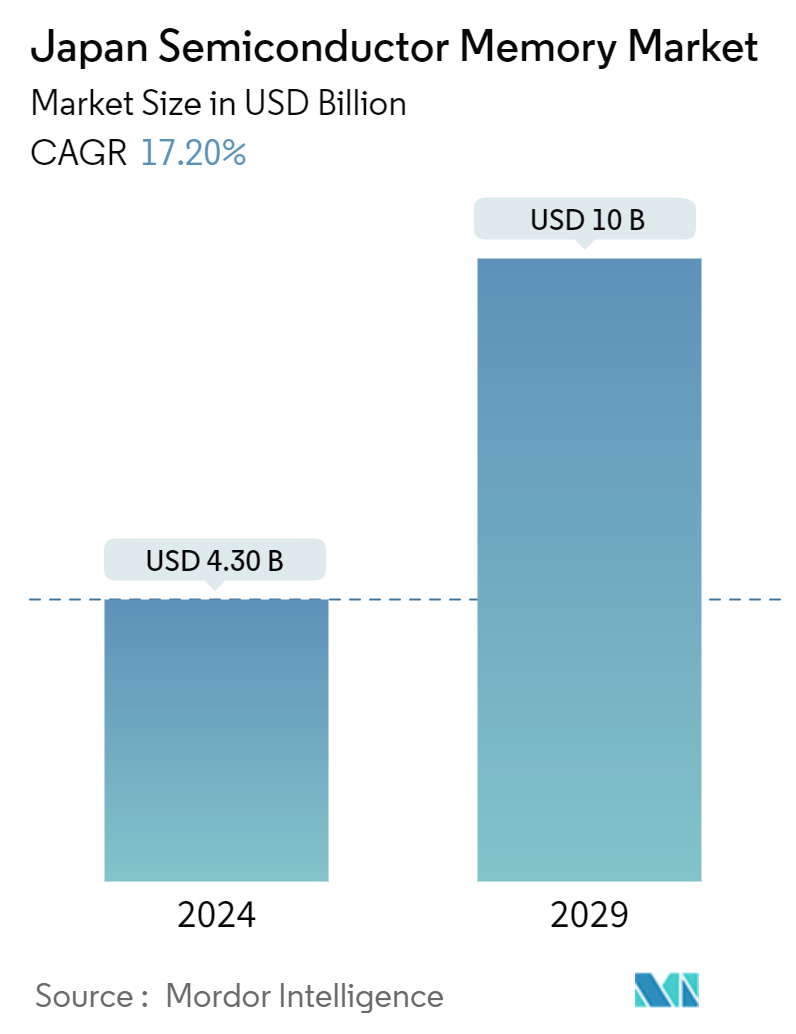Market Size of Japan Semiconductor Memory Industry

| Study Period | 2019 - 2029 |
| Base Year For Estimation | 2023 |
| Market Size (2024) | USD 4.30 Billion |
| Market Size (2029) | USD 10 Billion |
| CAGR (2024 - 2029) | 17.20 % |
| Market Concentration | Low |
Major Players*Disclaimer: Major Players sorted in no particular order |
Japan Semiconductor Memory Market Analysis
The Japan Semiconductor Memory Market size is estimated at USD 4.30 billion in 2024, and is expected to reach USD 10 billion by 2029, growing at a CAGR of 17.20% during the forecast period (2024-2029).
• Smartphones, tablets, and other consumer electronics are among the largest consumers of semiconductor memory. As these devices become more powerful and feature-rich, they require more memory to function properly. The increasing demand for these devices drives the demand for semiconductor memory in Japan.
• Some of the automotive ADAS manufacturers have already been using memory devices. For Example, Bosch uses the automotive-grade Serial NOR Flash memories from Cypress Semiconductor Corporation, which Infenion now acquires to manufacture its video-based Advanced Driver Assistance Systems (ADAS). The usage is expected to boost the storage of system boot code and algorithms at temperatures up to +125°C.
• As Japan is prone to natural disasters, companies in the region use data centers to secure their business continuity. Japan has not produced a cloud giant, so Chinese and American companies are rushing to sell cloud services to businesses in the world's third-largest economy. The global data center players are building homes for all those cloud servers in Japan's emerging markets. Such factors are expected to significantly boost the country's adoption of semiconductor memory.
• Moreover, researchers from organizations and regional universities are trying to develop high-speed next-generation memory to cater to the increasing applications of AI and IoT devices and their growing amount of data. For instance, in May 2023, Micron Technology announced it would invest up to JPY 500 billion (USD 3.6 billion) in Japan for the next few years, with support from the Japanese government, for next-generation memory chips.
• The pandemic highlighted the importance of having a secure supply of semiconductors. This has led to increased investment in semiconductor manufacturing capacity worldwide, including in Japan. The pandemic also increased the focus on supply chain resilience. Semiconductor manufacturers are now looking to diversify their supply chains and reduce their reliance on a single source of materials or components.
Japan Semiconductor Memory Industry Segmentation
Semiconductor memory helps electronic devices to store data. It is commonly used in digital electronic devices, such as computers, smartphones, and tablets, to store data that needs to be accessed quickly and easily. The Japan Semiconductor Memory Market Is Segmented By Type (DRAM, SRAM, NOR Flash, NAND Flash, ROM & EPROM) and Application (Consumer Products, PC/Laptop, Smartphone/Tablet, Data Center, Automotive). The Report Offers Market Size and Forecast for All The Above Segments In Value (USD).
| Type | |
| DRAM | |
| SRAM | |
| NOR Flash | |
| NAND Flash | |
| ROM & EPROM | |
| Others |
| Application | |
| Consumer Products | |
| PC/Laptop | |
| Smartphone/Tablet | |
| Data Center | |
| Automotive | |
| Other Applications |
Japan Semiconductor Memory Market Size Summary
The Japan semiconductor memory market is poised for significant growth, driven by the increasing demand for memory in consumer electronics such as smartphones and tablets, which require more advanced and high-capacity memory solutions. The market is also experiencing a surge in demand from the automotive sector, where memory devices are used in advanced driver assistance systems (ADAS) and in-vehicle infotainment systems. Additionally, the rise of cloud services and data centers, spurred by Japan's vulnerability to natural disasters, is further propelling the demand for semiconductor memory. The focus on developing next-generation memory solutions to support AI and IoT applications is also contributing to the market's expansion, with substantial investments from major players like Micron Technology.
The market landscape is characterized by a high degree of fragmentation, with key players such as Samsung Electronics, Micron Technology, SK Hynix, and STMicroelectronics actively engaging in strategic partnerships and technological innovations to maintain a competitive edge. The ongoing advancements in NAND flash memory technology, including the development of 4D NAND Flash, are enhancing the performance and cost-effectiveness of memory solutions, thereby driving their adoption in various applications. The increasing smartphone penetration, coupled with the launch of high-spec models and the expansion of 5G technology, is expected to sustain the demand for semiconductor memory in Japan, making it a critical component in the country's technological ecosystem.
Japan Semiconductor Memory Market Size - Table of Contents
-
1. MARKET INSIGHTS
-
1.1 Market Overview
-
1.2 Industry Attractiveness - Porter's Five Forces Analysis
-
1.2.1 Threat of New Entrants
-
1.2.2 Bargaining Power of Buyers/Consumers
-
1.2.3 Bargaining Power of Suppliers
-
1.2.4 Threat of Substitute Products
-
1.2.5 Intensity of Competitive Rivalry
-
-
1.3 Technology Snapshot
-
1.4 Impact of Macroeconomic Factors on the Market
-
-
2. MARKET SEGMENTATION
-
2.1 Type
-
2.1.1 DRAM
-
2.1.2 SRAM
-
2.1.3 NOR Flash
-
2.1.4 NAND Flash
-
2.1.5 ROM & EPROM
-
2.1.6 Others
-
-
2.2 Application
-
2.2.1 Consumer Products
-
2.2.2 PC/Laptop
-
2.2.3 Smartphone/Tablet
-
2.2.4 Data Center
-
2.2.5 Automotive
-
2.2.6 Other Applications
-
-
Japan Semiconductor Memory Market Size FAQs
How big is the Japan Semiconductor Memory Market?
The Japan Semiconductor Memory Market size is expected to reach USD 4.30 billion in 2024 and grow at a CAGR of 17.20% to reach USD 10 billion by 2029.
What is the current Japan Semiconductor Memory Market size?
In 2024, the Japan Semiconductor Memory Market size is expected to reach USD 4.30 billion.

